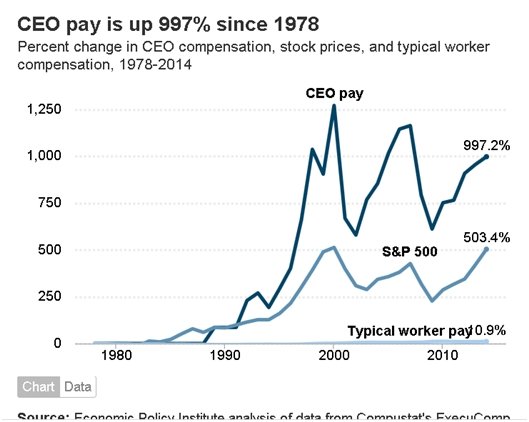Obstructed Report: US CEO to Worker Wage Disparity as High As 5,000 to1
by revoltingpeasant 1 June 2K18

Years of top corporate CEO and allied obstruction to consumer and worker protection legislation blocked the release of a report on the wage gap between corporate heads and an average employee. The obstruction was finally defeated after years of effort from a varied group of persistent activists including Democrat and other lawmakers, labor unions and the American Federation of Labor and Congress of Industrial Organizations (AFL-CIO), institutional investors, state treasurers, and others.
A main driver of the push to make the information public was Minnesota’s Democratic US congressman Keith Ellison.

photo from The Hill
The finally released data revealed details for the first time about the differences in income between the average employee and the respective CEO.
While it was no secret that the wage gap has gone viral in recent years, the actual numbers were not available because of intense resistance to its release from Republicans in Congress, government departments, corporate lobbyists, and predictably, many top corporate heads.
The Trump Administration and President Trump personally strongly supported and still support that resistance.
The study called Rewarding Or Hoarding? resulted from the 2010 Dodd-Frank Wall Street Reform and Consumer Protection Act, which was a response to the 2008 financial crash. The law made it mandatory for public corporations to report the compared wages of an average employee and the CEO.

From 1978 the average CEO salary in the US grew an average 997.2%; a median worker's pay increased by 0.9%.
image Economic Policy Institute
One extreme example of pay disparity is toy manufacturer Mattel. An average employee at the Barbie Doll maker would need to work for just under 5,000 years to earn what the CEO is making annually now.
The Act is imperfect. For example, the corporations don't have to report contractors, and there is a lot of wiggle room with foreign workers employed by the company. One example cited was Newmont Mining whose website indicates 30,000 workers and contractors, but the company reported 12,500.
Despite such shortcomings in the Act, the fear of making the disclosure motivated enough resistance to keep the reporting unimplemented since 2010.
The forcefulness of that resistance makes sense when the backlash is considered. Consumers could avoid greedy companies, the knowledge would provide negotiating leverage for trade unions, it would influence investors, and, most likely inconsequentially, create bad optics for the CEOs and corporations themselves. But people accustomed to orbiting in such rarefied strata don't do humility well. One example of this is exemplified by the argument against revealing such wage disparity put forth by Ronald L. Havner, CEO of Public Storage52:
Comparing what I do to the median employee is not even apples and oranges. It’s more like fruit compared to Star Wars. They don’t know how to allocate capital, and their educational level and skill set is vastly different…People have decisions to make as to whether they want to improve themselves and get higher paying jobs. Some people decide to do that and others don’t.”
Ellison wasn't impressed with such argument
that executive suite compensation is a just reward for the skillful exercising of their business talents. "Truth is, they’re doing nothing except extracting value and wealth from hard working people because they have economic advantages."
Havner was quoted in Rewarding Or Hoarding, a downloadable PDF file.
The Executive Summary to the report is available here.
Your posts are getting better:)
Thanks.
I prefer to make films but I can't do that right now.
So if I'm going to write, I may as well put my heart into it.
I like writing too, it's just so much fun playing with all the photographic toys.
I'm finding that the more I get my head into writing again, the more I'm finding about Steemit that I really like.
You're in a good place ATM, with the support of information war. You are doing better than most. A good solid 3 paragraphs++ with links and verifiable sources is about right. Steemit is OK for video too, especially short film. There is dtube and dlive, that is part of the steemit echo-system for video. The other good news is I may not have to fund your dustsweeper account after all:) Also go find some articles on how the echo-system actually works/especially on voting and steem power. You should be building up you voting power as much as possible by powering up, to increase your own voting power and get higher payouts on posts and influence on the platform.
Thanks, I appreciate the advice.
The biggest problem is me. I still haven't sorted out why dtube won't let me sign in, or even some of the rudimentary basics.
Life is a bit of a load right now, and when I get to Steemit I usually have several issues on my mind. Writing about them is a lot funner than fighting the learning curve on dry tech stuff.
But it's coming, slowly. I'm getting help from some people, you included, and that helps a lot.
I'm getting motivated; I've been here just coming up to 2 months and I've got over 200 followers. I don't know if that's good, but it seems so to me. And only a couple of encounters with extreme opinions, but I appreciate that too. I even upvote most of the snarky ones :)